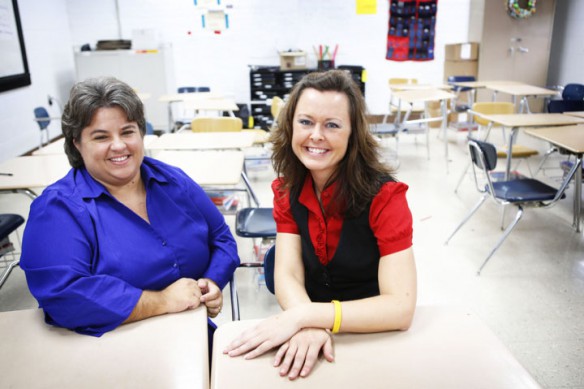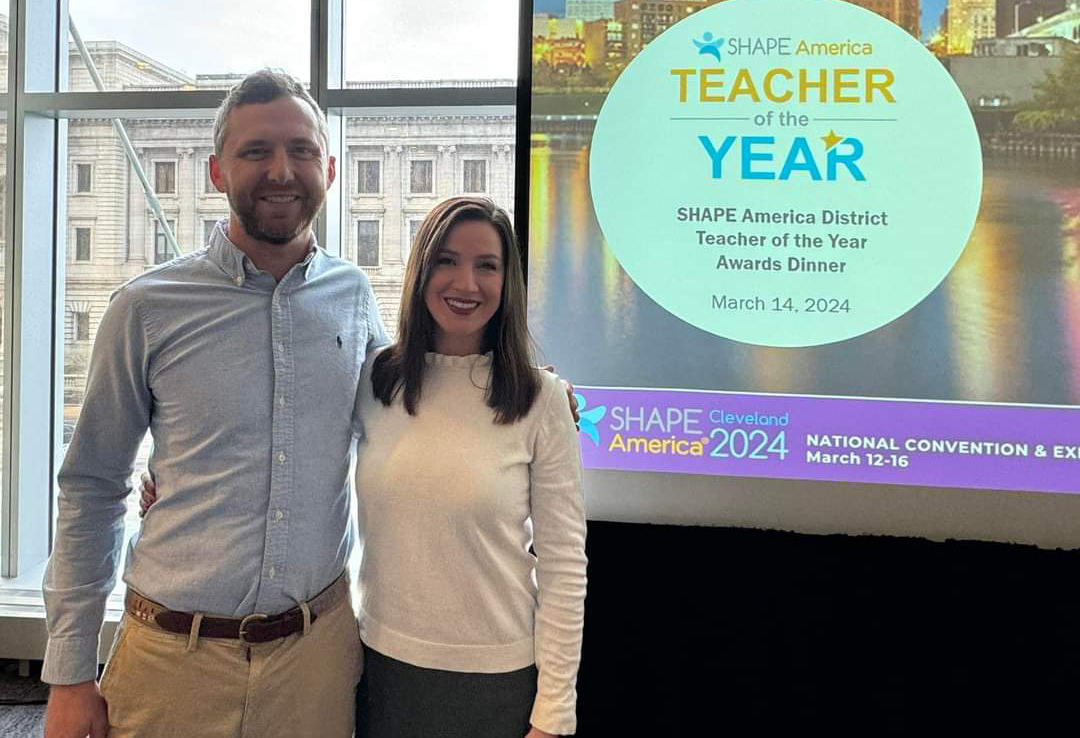
Special education teacher Stephanie Karl and mathematics teacher Sara Matthews co-teach at Caverna High School (Caverna Independent).
Photo by Amy Wallot, Sept. 18, 2012
By Susan Riddell
susan.riddell@education.ky.gov
Last year, Michelle Gross, a mathematics teacher at Spencer County Middle School, co-taught with a special education teacher who was in her mathematics classes for a half-day. The teacher, Angela Walters, then went to Spencer County High School to co-teach for the remainder of the day.
Gross said many of her students had a negative attitude about mathematics and school in general.
During a geometry lesson, Walters shared what the high school geometry students were learning and how what the middle school students were currently learning was so essential to what they would learn in high school.
“I think that lesson really helped our students see a perspective beyond our classroom,” Gross said.
Gross said that is one example why co-teaching (short for collaborative teaching) has really paid off in her classroom. This year she is co-teaching a mathematics intervention class along with Daniel Cox, another mathematics teacher at the school.
“We both bring different perspectives to the class,” Gross said. “Mr. Cox may be able to show a strategy that I didn’t think about using.”
Gross said Cox is really good at breaking down the steps of a mathematics problem, “where I have strength in reflection and goal setting,” she said.
“With students needing interventions, they need goals to work toward. I am able to do goal setting with the students and have them reflect on how they are doing.”
Cox, meanwhile, will take something students are struggling with and present it in a different way so that they better understand.
“Our students have made a lot of gains (since) we have been in school,” Gross said.
At the beginning of the year, seven students performed at a 3rd-grade level; 26 at a 4th-grade level; and three at a 5th-grade level. Seven weeks later, two students remained at a 3rd-grade level, but there only were six students at a 4th-grade level. Twenty students were at a 5th-grade level, and eight had improved to a 6th-grade level based on a combination of Measures of Academic Progress testing and performance on AimsWeb.
Gross said another pair of mathematics teachers had small classroom numbers this year, so they decided to combine the class and co-teach 7th-grade mathematics. “They are seeing quite a bit of success with this group,” Gross said.
The regular classroom teacher/special education teacher is the setup for Sara Matthews and Stephanie Karl at Caverna (Independent) High School. Both have been co-teaching in some form at least seven years; Matthews as a mathematics teacher and Karl as a special education teacher.
Matthews said the four years she has been co-teaching at Caverna High have been an authentic experience, and it has given her a greater insight into accommodating for lower-achieving students and special needs students.
“Co-teaching has also given me knowledge on grouping students based on learning style needs as well as ability levels,” Matthews said.
Karl has attended mathematics professional developments to increase her mathematics content knowledge along with co-teaching training. She and Matthews also attended the Project Select training through the Green River Regional Education Cooperative.
Karl said co-teaching has helped her become more adaptable to different situations.
“I am mainly with Ms. Matthews but may also go into other teachers’ classrooms,” she said. “Every teacher is different, so as the ‘flexible’ teacher, I have to adjust and adapt to each classroom, teacher and group of students.”
Co-teaching has increased her content knowledge, which Karl then transfers to her students. It “has widened my perspective and understanding of how to give all students the opportunity to be academically successful and embrace their various learning styles,” Karl said.
Co-teaching isn’t just for mathematics.
Paul Mullins, principal at LaRue County High School, said his school has between 15-20 classrooms that use co-teaching, including four English/language arts and five science rooms.
“It’s a great concept for our school, and I strongly believe in co-teaching,” Mullins said. “We’ve had several positives come from co-teaching. It has worked so well for both our teachers and our students.”
Caverna High co-teaches in mathematics, science, language arts and social studies.
“We used to have a collaborative teacher in Spanish as well, but have not been able to do that in the last couple of years due to numbers,” Karl said.
“Co-teaching is across the board in all content areas with support provided in any classes that need it,” Matthews added.
Playing to each other’s strengths, more planning time and more time for data collection and analysis are other benefits to co-teaching, Gross said.
It’s critical for success that co-teachers “think outside of yourself,” she said. “I had to stop thinking of it as ‘my’ classroom, and realize that different personalities and ways of thinking are going to help the students more than just my way.”
Toyah Robey, who is director of the Kentucky Department of Education’s Division of Student Success, is involved with the Co-Teaching for Gap Closure Initiative that is working to close achievement gaps for students with disabilities.
In the special education teacher/regular teacher model, Robey said student comments and resistance are two indicators that co-teaching isn’t working in a classroom.
“Ideally, you want to see a classroom where you just can’t tell which one is the regular teacher and which one is the special education teacher,” she said. “That’s when you know it’s working well.”
Whether planning lessons together or teaching together, student benefit is the biggest gain from two different insights regarding content, Matthews said.
“Through intentional planning together, we can be more specific to individual student needs with presentation of the content and activities focusing on daily learning targets that are aligned with Kentucky standards,” Matthews said. “It is like a tag team effort.”
MORE INFO …
Michelle Gross, michelle.gross@spencer.kyschools.us, (502) 477-3260
Stephanie Karl, stephanie.karl@caverna.kyschools.us, (270) 773-2828
Sara Matthews, sara.matthews@caverna.kyschools.us, (270) 773-2828
Paul Mullins, paul.mullins@larue.kyschools, (270) 358-2210
Division of Learning Services contacts
Laura McCullough, laura.mccullough@education.ky.gov, (502) 564-4970, ext. 4113
Denise Bailey, denise.bailey@education.ky.gov, (502) 564-4970, ext. 4101
Christel Hockensmith, christel.hockensmith@education.ky.gov, (502) 564-4970, ext. 4120







Leave A Comment